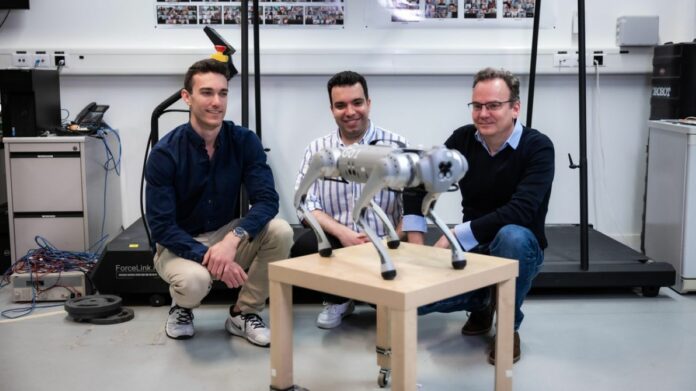Animals with four legs easily switch between gaits. Although energy efficiency is one cause of gait changes, other determinant elements, such as topographical characteristics, also play a part.
However, despite the growing number of studies on gait transitions in robotics and biology, there still needs to be a clear consensus regarding the underlying mechanisms and criteria determining why gait transitions occur in different conditions.
In a new study led by the BioRobotics Laboratory in EPFL‘s School of Engineering, a four-legged robot has learned to avoid falls by spontaneously switching between walking, trotting, and pronking. The robot was trained with machine learning called deep reinforcement learning (DRL).
The robot learned to transition from trotting to pronking to navigate challenging terrain with gaps ranging from 14 to 30cm. The study explains why and how such gait transitions occur in animals.
PhD student Milad Shafiee, the first paper author, said, “Previous research has introduced energy efficiency and musculoskeletal injury avoidance as the two main explanations for gait transitions. Biologists have recently argued that stability on flat terrain could be more important. But animal and robotic experiments have shown that these hypotheses are not always valid, especially on uneven ground.”
Scientists were keen to know why gait transitions occur: viability or fall avoidance. To test their new hypothesis, they used DRL to train a quadruped robot to cross various terrains.
They discovered that, on flat terrain, various gaits exhibited varying degrees of resilience against chance pushes. Like quadruped animals, the robot transitioned from a walk to a trot to preserve survival. Furthermore, to prevent falls, the robot instinctively changed from trotting to pronking when encountering sequential gaps in the trial surface. Furthermore, the only thing that such gait adjustments enhanced was viability.
Shafiee explains, “We showed that viability leads to the emergence of gait transitions on flat terrain and challenging discrete terrain, but energy efficiency is not necessarily improved. It seems that energy efficiency, which was previously thought to be a driver of such transitions, maybe more of a consequence. When an animal navigates challenging terrain, its priority is likely not falling, followed by energy efficiency.”
When modeling locomotion control in their robot, the researchers considered the three interdependent components that govern animal movement: the brain, spinal cord, and bodily sensory data. They trained a neural network to mimic how the brain sends messages to the body through the spinal cord as the robot navigated an experimental terrain using deep reinforcement learning.
The team weighed the three potential learning objectives—energy efficiency, force reduction, and viability. According to a series of computer simulations, viability was the only one of these three objectives that caused the robot to alter its gait independently without the scientists’ guidance.
The team highlights that these discoveries are the most dynamic crossing of such enormous consecutive gaps for a quadrupedal robot and the first learning-based locomotion architecture in which gait transitions emerge spontaneously during the learning process.
Shafiee says, “Our bio-inspired learning architecture demonstrated state-of-the-art quadruped robot agility on the challenging terrain.”
Scientists are now looking forward to expanding their work with additional experiments that place different types of robots in a wider variety of challenging environments.
Journal Reference:
- Shafiee, M., Bellegarda, G. & Ijspeert, A. Viability leads to the emergence of gait transitions in learning agile quadrupedal locomotion on challenging terrains. Nat Commun 15, 3073 (2024). DOI: 10.1038/s41467-024-47443-w
